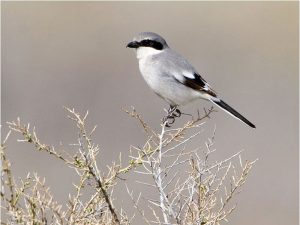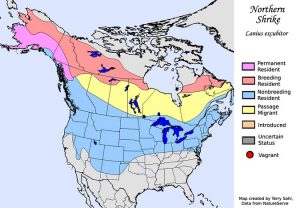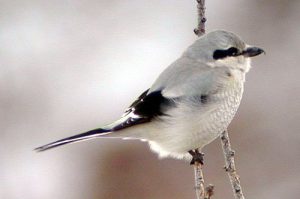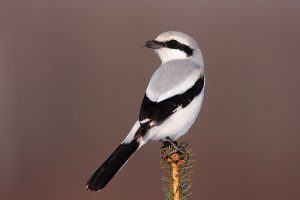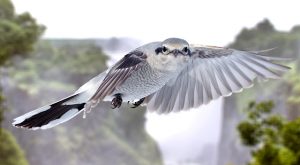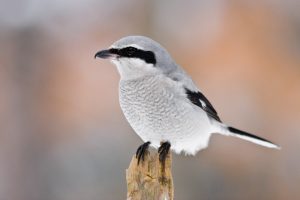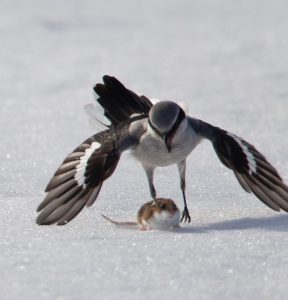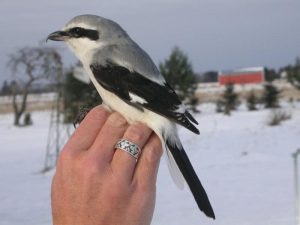Northern Shrike
Northern Shrike is a species of medium- to large-sized predatory songbirds that spend the summer in the northern territories of Asia and Europe, as well as North America including Canada and Alaska, but they winter south in the temperate regions. These passerine birds are characterized by a large head, a sturdy beak that is curved at the end, and medium-long black tail with white corners.
Don’t Let The Small Stature of Northern Shrike’s Fool You!
The little songbird is known for its distinct and aggressive territorial behavior, which plays a key role in its survival and reproductive success. Here are some details about its territoriality:
- Territorial Defense:
Northern Shrikes are highly territorial, especially during the breeding season. A single pair of shrikes typically occupies a well-defined territory that can range from 10 to 30 acres, depending on the habitat. The male plays a key role in defending the territory, using vocalizations and physical displays to ward off intruders, including other shrikes. - Perch Guarding:
One of the most noticeable behaviors of a Northern Shrike is its use of prominent perches from which it surveys its territory. These high vantage points allow the bird to spot potential threats or intruders. The shrike will actively defend these perches, chasing off any competing shrikes or predators that come too close. - Vocalization:
During the breeding season, the Northern Shrike is particularly vocal, using its song to announce its presence and warn other birds to stay away. The shrike’s call can be a series of harsh, chattering sounds that carry over long distances, reinforcing the bird’s territorial claims. - Aggressive Interactions:
If another Northern Shrike enters its territory, the resident bird may engage in aggressive aerial chases, displaying its sharp talons and powerful flight skills. These chases can be intense and are aimed at driving away the competitor. The Northern Shrike’s territorial aggression is particularly important during nesting, as it helps secure resources and protect its young. - Winter Territoriality:
Unlike many other birds, Northern Shrikes may also display territorial behavior during the winter months, especially in areas with abundant food. They may hold territories around rich food sources like berry bushes or areas with a high density of small mammals or insects. While their winter territories are not as fiercely defended as in the breeding season, the shrike still engages in territorial disputes when necessary.
Scientific Classification
| Kingdom | Animalia |
| Phylum | Chordata |
| Class | Aves |
| Order | Passeriformes |
| Family | Laniidae |
| Genus | Lanius |
| Scientific Name | Lanius excubitor |
Quick Information
| Similar Species | Southern gray shrike, Chinese gray shrike, Loggerhead shrike, Lesser gray shrike |
| Other Names | Northern gray shrike, Pie-grièche grise (French), Great grey shrike (British) |
| Size | 8.7-10.2 inches (22-26 cm) |
| Wingspan | 12-14 inches (30-36 cm) |
| Weight | 2.1-2.5 oz (60-70 g) |
| Color | Pearl-gray back, white cheeks, chin, throat, and chest; deep black mask extending from the bill to the ear coverts, black wings with white patch |
| Distribution | Central Alaska, British Columbia, southern Canada, Newfoundland, California, and northeastern states in North America; UK, Spain, Italy, France, Sweden, Russia, Germany, Switzerland, Norway, and some other European countries; China, Japan, India, Iran, Nepal, Afghanistan, Saudi Arabia, and United Arab Emirates in Asia |
| Habitat | Semi-open grasslands with shrubs or medium/tall trees; breeds in partly open/scattered spruce woods and alder scrubs in taiga as well as the edges of tundra; during the winter, moves to semi-open lands with high perches or some brushy areas |
| Sound/Song | A mix of warbles, harsh tones, whistles, chatter, and trills; harsh greee, kweee, or jaaa as alarm calls; emits a knuk call when the young birds are threatened, uses the waik call to show submissive behavior and beg for food |
| Lifespan | 12 years |
| Diet | Small birds, large insects, voles and other rodents; occasionally eats reptiles including frogs, snakes, and lizards |
| Adaptations | Sharp, hooked beak, keen eyesight |
| Nesting | April or May |
| Nest Size | Outer diameter: 20-28 cmInner diameter: 8-12 cm Depth: 10-15 cm |
| Size of Clutch | 4-9 eggs |
| Egg Size (approx) | Length: 26 mmWidth: 19.5 mm |
| Number of Broods | Single brood a year though replacement clutches occur after nest loss |
| Incubation Period | 16-21 days |
| Predation and Competition | Carnivorous mammals, raptorial birds, little owls, and other predators |
| IUCN Conservation Status | Least Concern |
Behavior
These diurnal birds frequently travel through their range, living in groups containing more than six pairs and becoming solitary during the mating season. Their usual flying pattern is heavy and undulating, but they fly straight in a determined manner when attacking.
To hunt prey, the Northern Shrikes sit on exposed perches and once the prey is located, they pounce on it in rapid, powerful flight. Even though a small prey is seized with their feet, the vertebrates are killed with their hooked bill. Living prey is often impaled on spines, thorns, or barbed wire and then consumed later.
Mating and Reproduction
Northern Shrikes produce their offspring during the summer, usually once a year. During the breeding season, they develop strong monogamous pair bond that loosens over the winter. The male birds fly beyond their breeding range in search of potential mates. Once the female is encountered, the male performs courtship displays by fluttering the wings while singing or calling. Moreover, the male maintains caches to entice females, which then give begging calls. Actual copulation starts after the male passes the stored cache to the female. Both the sexes take part in building the nests, though the nest materials such as grasses, feathers, hair, twigs, and roots are collected by the male.
Life Cycle
After the eggs are laid in May, the female starts incubating while the male brings the food for her. At hatching, the offspring are pink-skinned, blind, and helpless, and they depend on their mother for food. Fledging at 2-3 weeks, the offspring become independent after 3-6 weeks. The juvenile birds reach sexual maturity at about 1 year of age.
Interesting Facts
- The scientific name of this species of shrike means, “sentinel butcher.”
- These birds kill more prey than they can instantly eat, and store the excess prey for consumption during food scarcity.
- They have open cup-shaped nests, which are so deep that the tail of a female is only visible while incubating.
References
- https://en.wikipedia.org/wiki/Great_grey_shrike
- https://www.audubon.org/field-guide/bird/northern-shrike
- https://www.allaboutbirds.org/guide/Northern_Shrike/id
- https://www.iucnredlist.org/species/103693263/112514794
Published on May 18th 2016 by Mark Matzeldelaflor under Coniferous Forest Animals.
Article was last reviewed on 5th December 2024.


